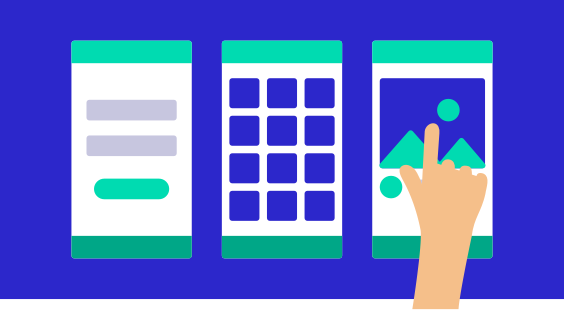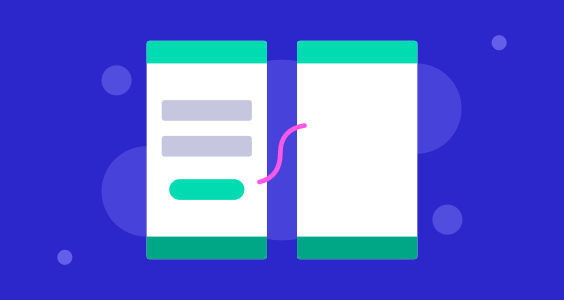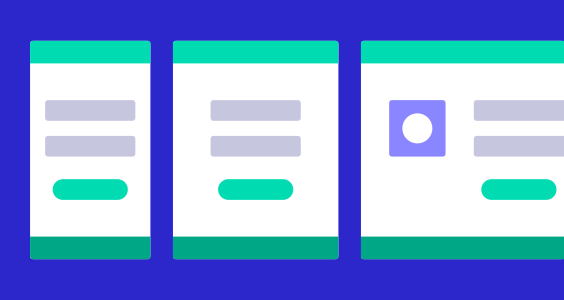Wrap up the course by discovering some extra functions.
Today, we’ve got a tour de force of some extra tips and tricks—our selection of both cool and useful functions in Figma. We’re not creating anything in particular today, but you might like to open up a fresh Figma file and try out these techniques, or continue iterating on the tablet/desktop design you created yesterday.
Time to complete: 30 minutes
Today’s tutorial
Just because you’re not tasked with making something today, it doesn’t mean this lesson is worth skipping. Trust us, the tips and tricks below will supercharge your design work, making you more efficient and comfortable with Figma.
1. Export to image files
It’s easy to export files from Figma, though you’ll probably find yourself doing it less often than in other programs, because of the live collaboration functionality that Figma offers. As a reminder, you can invite people to view your file directly, rather than having to export image files all the time. Export options are at the very bottom of the Properties panel when in the Design tab (you might have to scroll down).
- To export an individual Frame, first select the Frame (either in the Layers list, or by clicking the label above the Frame on the Canvas). Then click the “+” icon next to “Export” at the bottom of the Properties panel. Choose your desired settings, and click the “Export” button.
- To export a custom area of the document, you’ll need to create a “Slice” (keyboard shortcut [[S]] ). A Slice can cover an area within a frame, outside a frame, or across multiple frames. Once you’ve selected the Slice tool, click and drag to create the Slice, then use the Export options in the Properties panel as explained above.
- A cool aspect of Figma is that you can easily export the entire Canvas. Simply deselect everything (hit [[Escape]]), and set up your Export settings in the Properties, and you can export all your Frames in a single image.
2. Select all with same…
An extremely useful feature in Figma is the ability to select all layers within a file that share some property. For example, you could select all elements in a file with the same font. This enables you both to locate those elements and, if desired, to change all of them at once. Doing this is as simple as:
- Select an element with the property you want to find (e.g. a text box that uses the font “Inter”)
- Go to the Figma menu in the top-left, then Edit, and then select the option you want (e.g. “Select all with same font”)
- Figma will select all matching layers in the file. You can then make any edits you want to all those elements at the same time.
3. Paste vs Paste Over Selection
This distinction will be familiar to Adobe users. Figma’s standard “Paste” command is the equivalent of the “Paste in place” command in Adobe software: when you paste an element, Figma will position it in the same place as the original. This is useful if you need to paste an element into another frame, and ensure it’s in a consistent place. But sometimes you need to paste an element exactly where you’re currently located in the canvas. For this, you can use the “Paste over selection” command. The keyboard shortcut is [[⌘]][[ Shift⇧]][[ V]] on Mac, or [[Ctrl]][[Shift⇧]][[ V]] on PC.
4. Lock & unlock
Particularly when you’re working in files with lots of layers, it can be useful to lock some of them to prevent accidental selection and edits. To do this, select any object and hit [[⌘ Shift⇧ L]] (Mac), or [[Ctrl]][[Shift⇧]][[ L]] (PC). To unlock an element, make sure it’s selected in the Layers list, and repeat the same keyboard shortcut.
You can also access the Lock/Unlock commands by right-clicking (Mac/PC) or Ctrl-clicking (Mac) on a layer or by hitting the lock icon next to the object’s name in the Layers panel on the left.
5. Show & hide
The show/hide command works in much the same way as lock/unlock, but determines whether an element is visible within a frame. To toggle a layer’s visibility on and off, hit [[⌘]][[Shift⇧]][[H]] (Mac), or [[Ctrl]][[Shift⇧]][[ H]] (PC). Any hidden layer will be displayed in the Layers list as grayed out with a eyelash icon next to it.
6. Pixel grid
In addition to any other grids you’ve set up within individual frames, you can also turn on the “Pixel grid” for the whole file. This becomes visible when you zoom in close to a frame, and allows you to see where elements are sitting in relation to individual pixels.
- To toggle the Pixel grid on and off, hit [[⌘]][[']] (Mac), or [[Ctrl]][[']] (PC).
7. Pixel preview
Related to the pixel grid is “Pixel preview”. Ordinarily, when we’re working in Figma, we see sharp, vector-based shapes and text no matter how far we zoom in. However, when we export our screens to image files like PNGs, these vectors get “rasterized,” which means they get saved as pixel data. Turning on Pixel preview gives a preview of what the file will look like when it is exported to a pixel-based image.
- To toggle Pixel preview on and off, hit [[Ctrl]][[P]] (Mac) or [[Ctrl]][[Alt]][[Y]] (PC).
Note: Currently, Pixel preview will only preview pixels at 1x within the interface, not at Retina resolution. To work around this, you can set up your Frames at 2x size. Alternatively, you can Export as a PNG at 2x (go back up to the first tip if you need instructions on exporting as images).
8. Rasterize selection
Again related to these pixel tools, the Rasterize command allows us to convert a vector shape (like a rectangle, circle, or text), and permanently flatten it into pixel data. Usually this is not advisable, because it means you can’t go back and make edits to those elements—but there are occasions when it is useful. For example, you might not want to share the vector version of a logo until the design is finalized.
- To rasterize a layer, select the object you want to convert to pixel data, then go to the Figma menu in the top-left, then Object, and select “Rasterize selection” (it’s pretty far down in the list).
9. Show outlines
“Show outlines” does exactly what it says: it traces the edges of every element in a file, and hides other content (including strokes, fills, and images). This can be useful for getting a quick look at all the shapes, and the structure of those shapes, within a document. It also allows you to see objects that are off the edge of a frame, or underneath other objects… It's a bit like Figma X-ray vision.
- To toggle outlines on and off, [[⌘]][[Y]] (Mac) or [[Ctrl]][[Shift ⇧]][[3]] (PC)
10. Change the canvas color
For some, the default color of the canvas (#F5F5F5) might not contrast enough with the designs you’re working on. For us, anyway, we wanted a slightly darker gray in the background of the tutorials and sample files so you could more easily distinguish the canvas from the Frames.
- To change the color of the canvas itself (not the background of a Frame), have nothing selected in your document. You can deselect everything by hitting [[Escape]] on your keyboard. In the Properties panel on the right, there is a color swatch underneath where it says “Page.” Click on it and change it to whatever color you’d like! We suggest something neutral like the gray we used (#D9D9D9).
11. Light & dark modes
Have you ever watched one of the tutorials in this course and noticed that Figma’s interface is darker on your computer? You might have thought, “Are these tutorials outdated?” or “Is there something wrong with my version of Figma?” The answer to both of these questions is no! Figma now has light and dark themes, which you have the ability to change:
- Click on the Figma menu button in the top-left. From the drop-down, select Preferences and then Theme. Figma’s default setting is “System theme,” which means it will automatically change to the Light theme during the day and the Dark theme at night. If you prefer one over the other and don’t want it to alternate, simply click on Light or Dark.
12. Explore community resources
Our last tip is a big one: use the Figma Community resources! There are tons of templates for wireframes, icons, buttons, and loads of other design assets already created from designers around the world that you can use. There’s also plugins and widgets that can help enhance your designs and speed up your workflow. There are multiple ways to access Figma Community:
- While in a design file, you can search Community resources by clicking on the Resources button in the toolbar at the top. It’s between the Text tool and the Hand tool.
- If you’re on your account's homepage where you can see all of your files, there’s a button with a globe icon in the lower right corner labeled “Explore Community.”
Congrats! You completed Figma 101!
We hope that this course has equipped you with the core set of skills you need to create projects in Figma, and confidence to continue exploring some of the platform’s more advanced features.
What’s Next?
Over the past 7 days, you’ve had a taste of what it’s like to design user interfaces and visuals like logos and icons in Figma, the most popular UX/UI design app used by today’s UI/UX designers. Now that you’ve acquired these new skills, you’re probably wondering—what’s next?
If you’re looking to pursue a career in UX/UI design, take your design learning to the next level, with the UX Academy experience, our flagship digital product design bootcamp.
You’ll get started with UX Academy Foundations—an intro to UI design fundamentals that includes 35+ hands-on projects and a 10-hour design challenge. You’ll work 1:1 with an expert designer in 8 mentor sessions and walk away knowing if UX design is the right field for you before making the full financial commitment to UX Academy.
UX Academy Foundations is the perfect way to keep the creativity flowing and jumpstart a career change!











